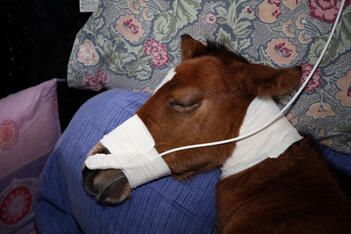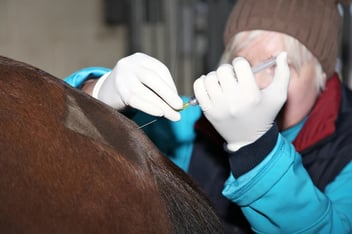Technique Tuesday - Emergency Kit for Foaling
This Technique Tuesday, our co-founder and equine veterinary surgeon, Kevin Corley (BVM&S PhD DACVIM DECEIM DACVECC MRCVS), is sharing his wealth of knowledge on assembling an indispensable emergency kit tailored for foaling.
Have questions or comments? Drop them in the comment form below, and Kevin will be more than happy to help! Stay tuned for more exciting insights and techniques.

Emergency kit for veterinarians on stud farms
Preparation and planning are key to a successful foal season. Over the next month we will cover some of the potential emergencies that can occur in neonatal foals and techniques needed to treat them. This week’s blog lists what vets should have to hand ready for before the start of the season.
Equipment for neonatal CPR
All equipment should be kept in a box which is readily accessible in an emergency, clearly labelled, checked and restocked so it is always ready to be used.
Essential veterinary equipment Foal CPR
· Nasotracheal tube (for sizes see table below).
· 5ml syringe to inflate cuff on tube.
· Self-inflating resuscitation bag (eg “The Bag II” Disposable resuscitator adult, Laerdal). You need a bag designed for human adult patients, not human pediatric patients.
· Small torch (flashlight)
· Epinephrine (adrenaline) 1mg/ml (1:1000) – keep 10ml in stock
· Five 2ml sterile syringes
· 20 Gauge 1 inch needles
· Bulb syringe
· Clean dry rough towels
Additional equipment to be available, if possible
· Oxygen cylinder and flow valve
· Steel 14 gauge 1-1.5inch needles
· Four 1L bags of lactated Ringer’s solution or Hartmann’s solution
· Fluid administration set
· 14 gauge IV catheter
Can be helpful in referral hospitals
· End-tidal carbon dioxide monitor
· Electrical defibrillator
Nasotracheal tubes
If you just get one, get a 9mm tube (a smaller tube can usually be made to work in a larger foal even if it is not optimal, but the opposite is obviously not true)
| Weight of foal | Typical Breed | Nasotracheal tube | Orotracheal tube |
| 20-35kg |
Premature foal Pony foal |
7mm 9mm |
9mm 10mm |
| 35-40kg |
Arab Large pony breed Premature foals
|
8mm 9mm |
9mm 10mm |
| 45-60kg |
Thoroughbred Warmblood |
9mm 10mm |
10mm 12mm |
| 60-80kg |
Draft breeds
|
12mm
|
12mm 14mm |
Equipment for dealing with emergencies
Mares:
Dystocia
· Head collar and twitch
· Tail bandage
· Clippers
· Scrub material
· Surgical gloves
· Scalpel blades and handle
· Elastoplast
· Local anesthetic
· Gloves
· Lubrication
· Soft foaling ropes, of different colours
Epidural injection equipment
· Epidural needle 18 ga 5-9cm (2-3.5 inches)
· epidural catheter kit (optional)
General equipment
· IV catheters
· IV infusion set
· Cuffed bag for rapid fluid delivery
· Colloids
· 5L bags of IV fluids
· Sedation
Medication for mares suspected to be haemorrhaging
No medication is proven to work – consider:
· Injectable Tranexamic acid (Cyklokapron) – should have 10 vials of 500mg each in stock
· Terlipressin – theoretically might be beneficial – reserve for cases where all other options exhausted as no data in horses.A possible one-off dose is 5mg to 10mg / 500kg horse.
· Yunnan Baiyao




